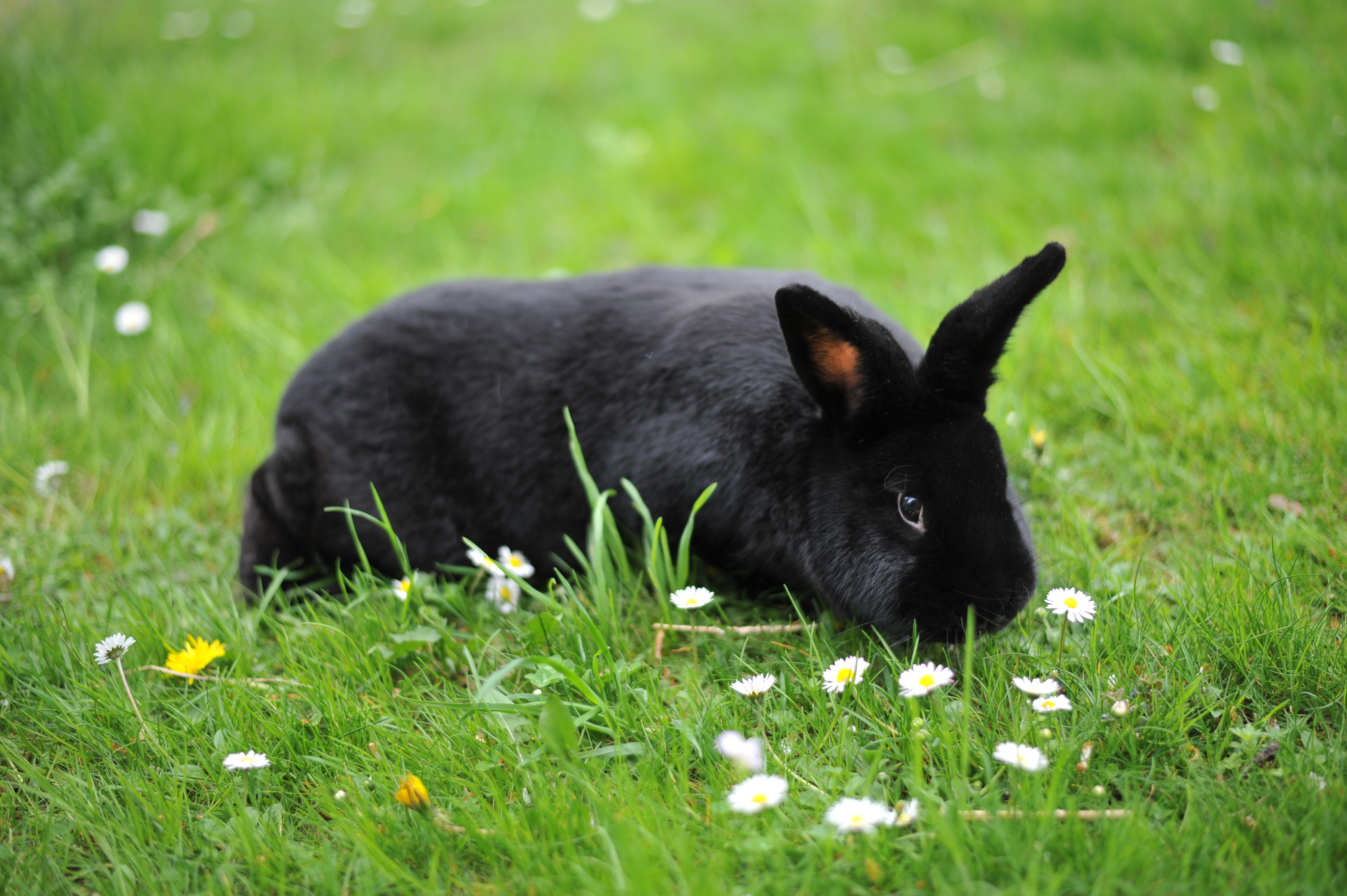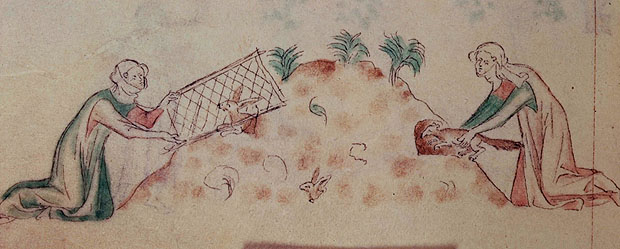|
Thrianta
The Thrianta (properly pronounced "Tree-on-tuh") is a breed of domestic rabbit that is brilliant red in color. Originating in the Netherlands, the Thrianta was further crossed with a Sachsengold (rabbit), German breed before being exported to the United Kingdom in the early 1980s. During the 1990s, the breed arrived in the United States from both the Netherlands and England. The Thrianta breed is recognized by the American Rabbit Breeders Association (ARBA) and by the British Rabbit Council (BRC). The Thrianta breed is rare in Australia with only a few active breeders. History Thriantas originated in Netherlands, the Netherlands, and were created by a school teacher, Mr. H. Andreae. Mr. Andrea had been working on orange-colored rabbits since 1938, using several different breeds. Andreae was very supportive of the House of Orange-Nassau and the queen Wilhelmina of the Netherlands, Wilhelmina. He also kept orange flowers in his front garden, in support of the royal house. On May 1, ... [...More Info...] [...Related Items...] OR: [Wikipedia] [Google] [Baidu] |
List Of Rabbit Breeds
As of 2017, there were at least 305 breeds of the domestic rabbit in 70 countries around the world raised for in the Agriculture, agricultural practice of Selective breeding, breeding and raising domestic rabbits as livestock for their value in meat, fur, wool, education, Scientific method, scientific research, entertainment and companionship in cuniculture. A rabbit breed is a distinct strain created through selective breeding (or occasionally natural selection) for specific characteristics, including size, fur, body type, color, feed conversion ratio, et cetera. Organizations such as the American Rabbit Breeders Association (ARBA) and the British Rabbit Council (BRC) have standards for the desired qualities of their respective recognized breeds. Each rabbit breed is considered to benefit when a reputable breeder strives to emulate the perfect example for the breed, defined by the individual breed standard by which it may be judged. The global diversity of breeds reflects the brea ... [...More Info...] [...Related Items...] OR: [Wikipedia] [Google] [Baidu] |
Domestic Rabbit
The domestic rabbit (''Oryctolagus cuniculus domesticus'') is the domestication, domesticated form of the European rabbit, a member of the lagomorph order. A male rabbit is known as a ''buck,'' a female as a ''doe,'' and a young rabbit as a ''kit''. There are hundreds of List of rabbit breeds, rabbit breeds, originating from all over the world. Rabbits were first domesticated and used for their Rabbit#As food and clothing, food and fur by Ancient Rome, the Romans. Rabbits may be housed inside, but the idea of the domestic rabbit as a house companion, a so-called ''house rabbit'' (similar to a house cat), was only strongly promoted starting with publications in the 1980s. Rabbits can be trained to use a litter box and taught to Animal training, come when called, but they require exercise and can damage a house or injure themselves if it has not been suitably prepared, based on their innate need to chew. Accidental interactions between pet rabbits and wild rabbits, while seemingly ... [...More Info...] [...Related Items...] OR: [Wikipedia] [Google] [Baidu] |
Netherlands
, Terminology of the Low Countries, informally Holland, is a country in Northwestern Europe, with Caribbean Netherlands, overseas territories in the Caribbean. It is the largest of the four constituent countries of the Kingdom of the Netherlands. The Netherlands consists of Provinces of the Netherlands, twelve provinces; it borders Germany to the east and Belgium to the south, with a North Sea coastline to the north and west. It shares Maritime boundary, maritime borders with the United Kingdom, Germany, and Belgium. The official language is Dutch language, Dutch, with West Frisian language, West Frisian as a secondary official language in the province of Friesland. Dutch, English_language, English, and Papiamento are official in the Caribbean Netherlands, Caribbean territories. The people who are from the Netherlands is often referred to as Dutch people, Dutch Ethnicity, Ethnicity group, not to be confused by the language. ''Netherlands'' literally means "lower countries" i ... [...More Info...] [...Related Items...] OR: [Wikipedia] [Google] [Baidu] |
Sachsengold (rabbit)
This is a list of rabbit breeds not recognized by the American Rabbit Breeders Association (ARBA) or the British Rabbit Council (BRC). Alexandria The Alexandria Rabbit Line originates from Egypt, and got its name from the city of Alexandria. It is an Egyptian paternal rabbit line. It has a medium-sized rabbit, weighing . It has erect ears, and its fur can be found in brown, tan, or black. The line was created in 2007 by Prof. Alaa El-Raffa, the Nucleus Rabbit Unit, the Poultry Research Center, Department of Poultry Production, Faculty of Agriculture, Alexandria University. The Alexandria rabbit is a synthetic line which comes from the cross of two lines, one exotic line (V line) and other native (Black Baladi). The method of selection is individual selection on post-weaning daily gain from weaning. Altex Altex is a breed of domestic rabbit developed, beginning in 1994, for cuniculture, specifically for the commercial meat industry. The name ''Altex'' is derived from ''Al'' pl ... [...More Info...] [...Related Items...] OR: [Wikipedia] [Google] [Baidu] |
American Rabbit Breeders Association
The American Rabbit Breeders Association (ARBA) is a national club for domestic rabbits and cavy breeders. The ARBA is headquartered in Knox, Pennsylvania, in the United States. Its membership is composed of rabbit and cavy exhibitors, commercial breeders and pet owners in North America and many countries throughout the world. The ARBA serves to promote the domestic rabbit and cavy fancy, as well as commercial rabbit production. The American Rabbit Breeders Association sets official breed standards for recognized rabbit breeds and cavy breeds. Every five years the ARBA publishes ''The Standard of Perfection''. This book includes descriptions of a perfect example for each breed of rabbit or cavy, details all general disqualifications, includes a glossary of rabbit terms and describes the process of a breed or variety becoming recognized by the ARBA. The ARBA currently recognizes 52 breeds of rabbit and 13 cavy breeds. Organization The ARBA is run by a Board of Directors w ... [...More Info...] [...Related Items...] OR: [Wikipedia] [Google] [Baidu] |
British Rabbit Council
The British Rabbit Council (BRC) is an organisation for rabbit enthusiasts in the United Kingdom. Rabbits are the UK's third most popular pet. History The British Rabbit Council was formed in 1934 when the British Rabbit Society and the National Rabbit Council of Great Britain and her Dominions merged. Local rabbit clubs in the 1940s were able to affiliate to the BRC. In 1952, the chair of the BRC, Mr T Leaver, said that there had been difficulties in the rabbit industry during the war, partly because of lack of government support before the war. "Despite these many setbacks, Mr. Leaver declared, 'We are an optimistic crowd, and we will carry on.' There were now over five hundred judges, who wanted people to breed exhibition rabbits with beautiful fur." Women were active in supporting the club and providing refreshments at meetings, but the organisation wanted more women active in showing rabbits. In the same year, the society set up examinations for rabbit-keeping. The first Nat ... [...More Info...] [...Related Items...] OR: [Wikipedia] [Google] [Baidu] |
House Of Orange-Nassau
The House of Orange-Nassau (, ), also known as the House of Orange because of the prestige of the princely title of Orange, also referred to as the Fourth House of Orange in comparison with the other noble houses that held the Principality of Orange, is the current dynasty, reigning house of the Netherlands. A branch of the European House of Nassau, the house has played a central role in the Politics and government of the Netherlands (1581–1795), politics and government of the Netherlands and elsewhere in Europe, particularly since William the Silent organised the Dutch Revolt against Spain, Spanish rule, which after the Eighty Years' War (1568–1648) led to an Dutch Republic, independent Dutch state. William III of Orange led the resistance of the Netherlands and Europe to Louis XIV of France and orchestrated the Glorious Revolution in England that established parliamentary rule. Similarly, Queen Wilhelmina of the Netherlands was instrumental in the Dutch resistance during W ... [...More Info...] [...Related Items...] OR: [Wikipedia] [Google] [Baidu] |
Wilhelmina Of The Netherlands
Wilhelmina (; Wilhelmina Helena Pauline Maria; 31 August 1880 – 28 November 1962) was List of monarchs of the Netherlands, Queen of the Netherlands from 1890 until her abdication in 1948. She reigned for nearly 58 years, making her the longest-reigning monarch in Dutch history, as well as the List of longest-reigning monarchs, longest-reigning female monarch outside the United Kingdom. Her reign saw World War I, the Great Depression in the Netherlands, Dutch economic crisis of 1933 and World War II. The only surviving child of King William III of the Netherlands and Emma of Waldeck and Pyrmont, Wilhelmina ascended the throne at the age of 10 after her father's death in 1890, under her mother's regent, regency. After taking charge of government, Wilhelmina became generally popular for maintaining Dutch neutrality during the First World War and solving many of her country's industrial problems. By that time, her business ventures had made her the world's first female billionaire a ... [...More Info...] [...Related Items...] OR: [Wikipedia] [Google] [Baidu] |
German Invasion Of The Netherlands
The German invasion of the Netherlands (), otherwise known as the Battle of the Netherlands (), was a military campaign, part of Case Yellow (), the Nazi German invasion of the Low Countries (Belgium, Luxembourg, and the Netherlands) and France during World War II. The battle lasted from 10 May 1940 until the surrender of the main Dutch forces on 14 May. Dutch troops in the province of Zealand continued to resist the Wehrmacht until 17 May, when Germany completed its occupation of the whole country. The invasion of the Netherlands saw some of the earliest mass paratroop drops, to occupy tactical points and assist the advance of ground troops. The German Luftwaffe used paratroopers in the capture of several airfields in the vicinity of Rotterdam and The Hague, helping to quickly overrun the country and immobilise Dutch forces. After the devastating Nazi bombing of Rotterdam by the Luftwaffe on 14 May, the Germans threatened to bomb other Dutch cities if the Dutch forces refu ... [...More Info...] [...Related Items...] OR: [Wikipedia] [Google] [Baidu] |
East Germany
East Germany, officially known as the German Democratic Republic (GDR), was a country in Central Europe from Foundation of East Germany, its formation on 7 October 1949 until German reunification, its reunification with West Germany (FRG) on 3 October 1990. Until 1989, it was generally viewed as a communist state and described itself as a Socialist state, socialist "workers' and peasants' state". The Economy of East Germany, economy of the country was Central planning, centrally planned and government-owned corporation, state-owned. Although the GDR had to pay substantial war reparations to the Soviets, its economy became the most successful in the Eastern Bloc. Before its establishment, the country's territory was administered and occupied by Soviet forces following the Berlin Declaration (1945), Berlin Declaration abolishing German sovereignty in World War II. The Potsdam Agreement established the Soviet occupation zone in Germany, Soviet-occupied zone, bounded on the east b ... [...More Info...] [...Related Items...] OR: [Wikipedia] [Google] [Baidu] |




